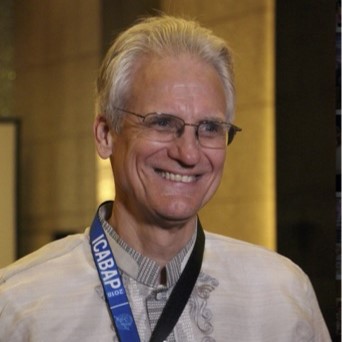|
|
| Brain as Behavior: Applying Behavioral Analysis to the Development of Brain-Machine Interfaces in Consciousness Disorders |
| Thursday, November 13, 2025 |
| 8:00 AM–8:50 AM |
| Altis Grand Hotel; Level -1; Londres |
| Area: BPN/PRA; Domain: Applied Research |
| Chair: Armando Machado (University of Aveiro, Portugal) |
| Presenting Author: ÓSCAR GONÇALVES (Universidade Portucalense Infante D. Henrique) |
| Abstract: In recent years, the study of consciousness disorders has become a central challenge in neuropsychology and clinical neuroscience. Traditionally, the assessment of these disorders—ranging from coma to unresponsive wakefulness syndrome and minimally conscious states—has relied on behavioral responses to structured sensory stimuli. However, a growing body of evidence has highlighted a significant rate of false negatives within this approach. Specifically, neuroimaging and neurophysiological studies have identified individuals who, despite exhibiting no overt behavioral response, demonstrate neural markers of stimulus processing consistent with covert consciousness or cognitive-motor dissociation.These findings have driven the development of experimental paradigms designed not only to detect passive neural responses (passive paradigms) but also to elicit task-specific brain activity indicative of volitional motor intent (active paradigms). As a result, real-time neurophysiological data can be translated into quantifiable behavioral outputs through virtual and robotic interfaces, redefining brain activity as an observable and analyzable functional response.This presentation will examine the role of functional behavior analysis in advancing brain-machine interface (BMI) systems for consciousness assessment and neurorehabilitation. We will discuss how these interfaces enable direct real-time modeling of brain activity and its translation into actionable outputs, offering new pathways for improving the diagnosis and treatment of consciousness disorders |
| Instruction Level: Intermediate |
| |
| ÓSCAR GONÇALVES (Universidade Portucalense Infante D. Henrique) |
 Óscar F. Gonçalves is currently a Full Professor at the Portucalense Infante D. Henrique University and a retired Full Professor of Neuropsychology at the University of Coimbra, Portugal. He has held teaching positions at the University of Porto (Assistant Professor), University of California Santa Barbara (Assistant Professor) and Northeastern University (Full Professor and Chair of the Department of Applied Psychology), as well as Full Professor and Director at the School of Psychology of the University of Minho. She graduated in Psychology from the University of Porto, in Portugal, and completed two doctorates: one in Psychotherapy and Counseling at the University of Massachusetts, Amherst – USA; and another in Neurosciences from the Faculty of Medicine of the University of Santiago de Compostela – Spain. Professor Óscar Gonçalves is a board-certified specialist in clinical and health psychology, with advanced specialties in both neuropsychology and psychotherapy. He is currently Coordinator of the PhD Program in Clinical Psychology and Counseling at Portucalense University. He is the author of more than 200 publications and 11 books. Professor Gonçalves is part of the editorial board of several international journals, being a former associate editor and current editor of the International Journal of Clinical and Health Psychology (Elsevier). Óscar F. Gonçalves is currently a Full Professor at the Portucalense Infante D. Henrique University and a retired Full Professor of Neuropsychology at the University of Coimbra, Portugal. He has held teaching positions at the University of Porto (Assistant Professor), University of California Santa Barbara (Assistant Professor) and Northeastern University (Full Professor and Chair of the Department of Applied Psychology), as well as Full Professor and Director at the School of Psychology of the University of Minho. She graduated in Psychology from the University of Porto, in Portugal, and completed two doctorates: one in Psychotherapy and Counseling at the University of Massachusetts, Amherst – USA; and another in Neurosciences from the Faculty of Medicine of the University of Santiago de Compostela – Spain. Professor Óscar Gonçalves is a board-certified specialist in clinical and health psychology, with advanced specialties in both neuropsychology and psychotherapy. He is currently Coordinator of the PhD Program in Clinical Psychology and Counseling at Portucalense University. He is the author of more than 200 publications and 11 books. Professor Gonçalves is part of the editorial board of several international journals, being a former associate editor and current editor of the International Journal of Clinical and Health Psychology (Elsevier). |
|
| |
| |
|
|
| Eye Contact: To Teach or Not to Teach? That Is Not the Question |
| Thursday, November 13, 2025 |
| 9:00 AM–9:50 AM |
| Altis Grand Hotel; Level -1; Londres |
| Area: VBC; Domain: Theory |
| Chair: Mark Galizio (University of North Carolina Wilmington) |
| Presenting Author: FRANCESCA DEGLI ESPINOSA (ABA Clinic) |
| Abstract: The behaviour of looking at people’s faces is one of the first operant responses and is implicated in setting the stage for all future social learning. Not only is visual social engagement considered an important measure of social cognition in developmental neuroscience, but its quantification has produced significant advances in the study of autism diagnostic tools in infants. At the behavioural level, looking at people’s faces provides us with information regarding the discriminative functions and reinforcing value of social stimuli, of people, of what they do and what they say. There is general scientific consensus that the establishment of early and frequent social learning experiences through visual engagement is an important objective in early intervention programmes that aim to alter a child’s developmental trajectory and to establish social and verbal behaviour under naturally occurring contingencies. In recent years, the question of whether teaching eye-contact to children with autism constitutes an important and ethical objective has been raised. I will argue that this question may be best answered by first understanding the behaviour of looking at people’s eyes and its controlling variables in the context of social learning. The current presentation will provide a conceptual analysis of the behaviour of looking to produce contact with the eyes as a reinforcer and video examples on how to establish it as offered behaviour in a social interconnected chain, without the involvement of reinforcers that are extrinsic to the interaction in young children with autism. |
| Instruction Level: Intermediate |
Learning Objectives: 1. Describe the elements of a social chain
2. Provide a behavioural analysis of the environmental contingencies that shape looking behaviour in childhood development
3. Define eye-contact as a social consequence for looking behaviour |
| |
| FRANCESCA DEGLI ESPINOSA (ABA Clinic) |
 Francesca’s current academic pursuit is the translation of cognitive and developmental descriptions of key processes in language and childhood development into an analysis of controlling variables, with the aim of deriving a technology to remediate deficits in children with autism. Her clinical and research work with humans focuses on early social responding, generative verbal behaviour and theory of mind. She was the 2023 recipient of the “Clinical Supervisor Award in Verbal Behavior” from the VB Special Interest Group of ABAI. Presently, she runs a small diagnostic and assessment clinic in the UK, and has taught advanced behaviour analysis in a number of postgraduate programmes in Italy, the UK and the US. She is a board member of the B.F. Skinner Foundation. She lives in Southampton, UK, with her husband and her two dogs, who daily challenge her knowledge and skills and have taught her to be a better behaviour analyst for the humans she serves. Francesca’s current academic pursuit is the translation of cognitive and developmental descriptions of key processes in language and childhood development into an analysis of controlling variables, with the aim of deriving a technology to remediate deficits in children with autism. Her clinical and research work with humans focuses on early social responding, generative verbal behaviour and theory of mind. She was the 2023 recipient of the “Clinical Supervisor Award in Verbal Behavior” from the VB Special Interest Group of ABAI. Presently, she runs a small diagnostic and assessment clinic in the UK, and has taught advanced behaviour analysis in a number of postgraduate programmes in Italy, the UK and the US. She is a board member of the B.F. Skinner Foundation. She lives in Southampton, UK, with her husband and her two dogs, who daily challenge her knowledge and skills and have taught her to be a better behaviour analyst for the humans she serves. |
|
| |
| |
|
|
| Pigeons’ Choosing to Go to Work: Using Reinforcement-Based Methods to Balance Animal Welfare With Research Needs |
| Thursday, November 13, 2025 |
| 10:30 AM–11:20 AM |
| Altis Grand Hotel; Level -1; Londres |
| Area: EAB; Domain: Basic Research |
| Chair: Marcelo Frota Lobato Benvenuti (University of São Paulo) |
| Presenting Author: TIMOTHY D. HACKENBERG (Reed College) |
| Abstract: As part of a larger program of research concerned with an animal model of gambling, we arranged conditions of social enrichment for a small group of pigeons. When not in their experimental sessions, the pigeons lived together in a free-flying aviary, interacting with each other and with a physical environment that included perches and nesting boxes. While this better approximated the pigeons’ natural environment, it also created some practical problems from a research perspective; namely, how to get the pigeons from the aviary each day to their work sessions in another room. To minimize human involvement and the potential stress of daily captures, we devised procedures whereby the pigeons chose to enter the experiment each day by flying into a box on the side of the aviary, from which they were transported to the operant chambers for their daily sessions. By the end of training, all pigeons were consistently entering the box on cue, for transport to the session, and this continued for the remainder of the two-year project, over which each pigeon chose to participate in hundreds of daily sessions. The findings show the power of reinforcement-based methods in addressing practical problems in animal enrichment and welfare. |
| Instruction Level: Intermediate |
Learning Objectives: 1. Participants will be able to define and give an example of social enrichment.
2. Participants will be able to describe some of the tradeoffs between animal welfare and research demands.
3. Participants will be able describe the training methods used to give pigeons choices to participate in the work sessions. |
| |
| TIMOTHY D. HACKENBERG (Reed College) |
 Tim Hackenberg has had the good fortune to work with and learn from great teachers and students over the years. He received a B.A. degree in Psychology from the University of California, Irvine in 1982 and a doctorate in Psychology from Temple University in 1987, under the supervision of Philip Hineline. Following a two year post-doctoral research position at the University of Minnesota with Travis Thompson from 1988-90, he served on the faculty in the Behavior Analysis program at the University of Florida from 1990-2009. He is currently a Professor of Psychology at Reed College in Portland Oregon. He has served on the Board of Directors of the Society for the Experimental Analysis of Behavior, of the Society for the Quantitative Analysis of Behavior, as Associate Editor of the Journal of the Experimental Analysis of Behavior, as President of Division 25 of the American Psychological Association, as the Experimental Representative to the ABAI Council, and as the first Director of the ABAI Science Board. His major research interests are in the area of behavioral economics and comparative cognition, with a particular emphasis on decision-making, token economies, and social behavior. In work funded by the National Science Foundation and the National Institutes of Health, he and his students have developed procedures for cross-species comparisons of complex behavior. Tim Hackenberg has had the good fortune to work with and learn from great teachers and students over the years. He received a B.A. degree in Psychology from the University of California, Irvine in 1982 and a doctorate in Psychology from Temple University in 1987, under the supervision of Philip Hineline. Following a two year post-doctoral research position at the University of Minnesota with Travis Thompson from 1988-90, he served on the faculty in the Behavior Analysis program at the University of Florida from 1990-2009. He is currently a Professor of Psychology at Reed College in Portland Oregon. He has served on the Board of Directors of the Society for the Experimental Analysis of Behavior, of the Society for the Quantitative Analysis of Behavior, as Associate Editor of the Journal of the Experimental Analysis of Behavior, as President of Division 25 of the American Psychological Association, as the Experimental Representative to the ABAI Council, and as the first Director of the ABAI Science Board. His major research interests are in the area of behavioral economics and comparative cognition, with a particular emphasis on decision-making, token economies, and social behavior. In work funded by the National Science Foundation and the National Institutes of Health, he and his students have developed procedures for cross-species comparisons of complex behavior. |
|
| |
| |
|
|
| An Evolutionary Approach to Verbal Behavior |
| Thursday, November 13, 2025 |
| 2:00 PM–2:50 PM |
| Altis Grand Hotel; Level -1; Londres |
| Area: PCH; Domain: Theory |
| Chair: Mark Galizio (University of North Carolina Wilmington) |
| Presenting Author: CARSTA SIMON (University of Agder, Norway) |
| Abstract: Verbal interactions are behavior-environment interactions that can be analyzed by the same means as other behavior. This analysis is rooted in evolutionary biology, as evolutionary principles offer explanations of behavior. The analysis presents data supporting induction, rather than strengthening by reinforcement, of verbal behavior through the actions of conversational partners. By examining the adaptation of verbal behavior through interaction, this talk explores how conversational dynamics shape communication. This evolutionary viewpoint highlights verbal interactions as adaptive responses influenced by social and environmental stimuli. By analyzing verbal behavior within an evolutionary framework, this approach opens new insights into how speech adapts and functions, offering a comprehensive view of the role of verbal interactions and the impact of conversational partners’ behavior on speech. Taking a molar multiscale approach (Baum, 2018), the empirical and theoretical points presented in this talk take the arguments that Skinner laid out in “Selection by Consequences” (1981) and in “Verbal behavior” (1957) to its logical conclusion. |
| Instruction Level: Intermediate |
| |
| CARSTA SIMON (University of Agder, Norway) |
 Carsta Simon is full professor at the University of Agder (Norway). She holds a Ph.D. degree in Behavior Analysis and a master's degree with distinction in Psychology. She is alumna of the German Academic Scholarship Foundation. In her empirical and conceptual work, she investigates what qualifies as meaningful behavioral units of analysis. She aims at understanding how behavior is selected by its effects on the organism’s environment in ontogeny and in phylogeny, how an organism's behavior shapes the environment, and the interplay between the two. Dr. Simon’s experimental work focuses on the molar dynamics of verbal behavior in conversations. She aims at contributing to an interdisciplinary integration of behavior analysis, behavioral ecology, and evolutionary theory. She co-organizes an open access zoom-based journal club on the Philosophy of Behavior Analysis and teaches university courses on a plethora of topics in English, the Scandinavian languages, and German. Carsta Simon is full professor at the University of Agder (Norway). She holds a Ph.D. degree in Behavior Analysis and a master's degree with distinction in Psychology. She is alumna of the German Academic Scholarship Foundation. In her empirical and conceptual work, she investigates what qualifies as meaningful behavioral units of analysis. She aims at understanding how behavior is selected by its effects on the organism’s environment in ontogeny and in phylogeny, how an organism's behavior shapes the environment, and the interplay between the two. Dr. Simon’s experimental work focuses on the molar dynamics of verbal behavior in conversations. She aims at contributing to an interdisciplinary integration of behavior analysis, behavioral ecology, and evolutionary theory. She co-organizes an open access zoom-based journal club on the Philosophy of Behavior Analysis and teaches university courses on a plethora of topics in English, the Scandinavian languages, and German. |
|
| |
| |
|
|
| Temporal Adjustment to Reinforcement Schedules and Response Induction |
| Thursday, November 13, 2025 |
| 4:30 PM–5:20 PM |
| Altis Grand Hotel; Level -1; Londres |
| Area: EAB; Domain: Basic Research |
| Chair: Armando Machado (University of Aveiro, Portugal) |
| Presenting Author: RICARDO PELLON (Universidad Nacional de Educacion a Distancia) |
| Abstract: Intermittent schedules of reinforcement induce behavior, a process that has not yet produced a theoretical consensus. However, it is now accepted as a general principle of reinforcement that takes into account which behaviors are more susceptible to conditioning. For example, many animals drink in association with eating, so scheduling food intermittently will induce water consumption, even though drinking is not required to obtain the food and animals are not deprived of water. This phenomenon, known as schedule-induced drinking, is the most studied example of schedule-induced behavior. Many similarities have been reported between schedule-induced drinking and traditional operant behaviors, such as lever pressing for food, leading to the suggestion that a common explanation will suffice for all types of behavior. However, one feature of these comparisons resists, namely the lack of proportionality of the temporal location of drinking to the length of the inter-reinforcement interval. This has been claimed to be an important feature of behavior controlled by its consequences, and a feature (or lack thereof) that must be accounted for in any theory that purports to address the phenomenon of induction. Here it will be reviewed the various experimental approaches we have used to address this question, including measuring the distributions of responses under a variety of different fixed-time and fixed-interval schedules, imposing consequences on the execution of responses at certain parts of inter-reinforcement intervals, or directly preventing the occurrence of behavior at such moments. The evidence collected could be accounted for by assuming that reinforcer delivery truncates responding when it occurs at the time of responding, but not when it occurs some time after the behavior is completed, leading to the possibility that reinforcement can act at different moments in time while preserving the location at which behaviors were initially reinforced. |
| Instruction Level: Advanced |
Learning Objectives: 1. identify the need of precise detailed mechanisms of action of reinforcers
2. distinguish and integrate different levels of analysis of behavior
3. accomplish how behavior is organized across time |
| |
| RICARDO PELLON (Universidad Nacional de Educacion a Distancia) |
 Ricardo Pellón graduated in Psychology in 1980 and defended his PhD in Experimental Psychology in 1987, both at Universidad Autónoma de Madrid (Spain). He has held research positions at the University of Cardiff, UK (1981-1984), and at the Addiction Research Center of the National Institute on Drug Abuse, Baltimore, USA (1990-1991). In 2005-2006 he spent a sabbatical at Arizona State University, USA, and in 2023 he enjoyed a study leave at the University of Auckland, New Zealand. He is currently Professor of Psychology at Universidad Nacional de Educación a Distancia (UNED), Madrid, Spain, where he leads the Experimental Analysis of Behavior Research Group and directs the Animal Learning and Behavior Lab, working mainly (but not exclusively) on animal models of excessive behavior, such as schedule-induced polydipsia and activity-based anorexia, both using laboratory rats as experimental subjects. He has published in international journals in the areas of learning and behavior, behavioral pharmacology, and neural substrates of behavior. He teaches undergraduate courses in psychology, supervises masters and doctoral students at various universities, and is usually involved in administrative aspects of university life. Ricardo Pellón graduated in Psychology in 1980 and defended his PhD in Experimental Psychology in 1987, both at Universidad Autónoma de Madrid (Spain). He has held research positions at the University of Cardiff, UK (1981-1984), and at the Addiction Research Center of the National Institute on Drug Abuse, Baltimore, USA (1990-1991). In 2005-2006 he spent a sabbatical at Arizona State University, USA, and in 2023 he enjoyed a study leave at the University of Auckland, New Zealand. He is currently Professor of Psychology at Universidad Nacional de Educación a Distancia (UNED), Madrid, Spain, where he leads the Experimental Analysis of Behavior Research Group and directs the Animal Learning and Behavior Lab, working mainly (but not exclusively) on animal models of excessive behavior, such as schedule-induced polydipsia and activity-based anorexia, both using laboratory rats as experimental subjects. He has published in international journals in the areas of learning and behavior, behavioral pharmacology, and neural substrates of behavior. He teaches undergraduate courses in psychology, supervises masters and doctoral students at various universities, and is usually involved in administrative aspects of university life. |
|
| |
| |
|
|
| Some Wisdom, Warnings, and Encouragements for Today’s Behavior Analysts From Pioneers and Pathfinders Past |
| Thursday, November 13, 2025 |
| 5:30 PM–6:20 PM |
| Altis Grand Hotel; Level -1; Londres |
| Area: PCH; Domain: Applied Research |
| Chair: Mark Galizio (University of North Carolina Wilmington) |
| Presenting Author: WILLIAM HEWARD (Ohio State University) |
| Abstract: Contemporary behavior analysis comprises philosophical assumptions, experimental methods, conceptual tools, interventions, and clinical practices developed on a foundation of discoveries, innovations, and insights by the field’s pioneers. Behavior analysis pathfinders and innovators featured in this talk include Donald Baer, Sidney Bijou, Betty Hart, Brian Iwata, Fred Keller, Ogden Lindsley, Ivar Lovaas, Jack Michael, Hank Pennypacker, Karen Pryor, Ellen Reese, Murray Sidman, B. F. Skinner, and Montrose Wolf. Their ideas about the purpose, methodology, and potential of a science of behavior are as relevant today as when first offered decades ago. This presentation will include a game of Who Said It? in which audience members can select which of four persons made specific quotations. |
| Instruction Level: Basic |
Learning Objectives: 1. Name three behavior analysis pioneers, pathfinders, or innovators with whose work this presentation introduced or reacquainted me.
2. Describe two strategies recommended by behavior analysis pioneers for dealing with a complex or heretofore unsolved problem.
3. Name the behavior analyst who said, “Don’t try walking to Chicago on your hands.” and explain why he offered that bit of advice. |
| |
| WILLIAM HEWARD (Ohio State University) |
 William L. Heward, Ed.D., BCBA-D, is Professor Emeritus in the College of Education and Human Ecology at The Ohio State University. He has taught at universities in Brazil, Japan, Portugal, and Singapore and lectured or given workshops in 25 other countries. A Fellow and Past President of the Association for Behavior Analysis International, Bill’s publications include co-authoring the books, Applied Behavior Analysis (3rd ed., 2020), Exceptional Children: An Introduction to Special Education (12th ed., 2022), and Let’s Make a Contract: A Positive Way to Change Your Child’s Behavior (2022). Awards recognizing Dr. Heward's contributions to behavior analysis and education include the Ellen P. Reese Award for Communication of Behavioral Concepts from the Cambridge Center for Behavioral Studies, the Fred S. Keller Behavioral Education Award from the American Psychological Association's Division 25, and the Distinguished Psychology Department Alumnus Award from Western Michigan University. William L. Heward, Ed.D., BCBA-D, is Professor Emeritus in the College of Education and Human Ecology at The Ohio State University. He has taught at universities in Brazil, Japan, Portugal, and Singapore and lectured or given workshops in 25 other countries. A Fellow and Past President of the Association for Behavior Analysis International, Bill’s publications include co-authoring the books, Applied Behavior Analysis (3rd ed., 2020), Exceptional Children: An Introduction to Special Education (12th ed., 2022), and Let’s Make a Contract: A Positive Way to Change Your Child’s Behavior (2022). Awards recognizing Dr. Heward's contributions to behavior analysis and education include the Ellen P. Reese Award for Communication of Behavioral Concepts from the Cambridge Center for Behavioral Studies, the Fred S. Keller Behavioral Education Award from the American Psychological Association's Division 25, and the Distinguished Psychology Department Alumnus Award from Western Michigan University. |
|
| |